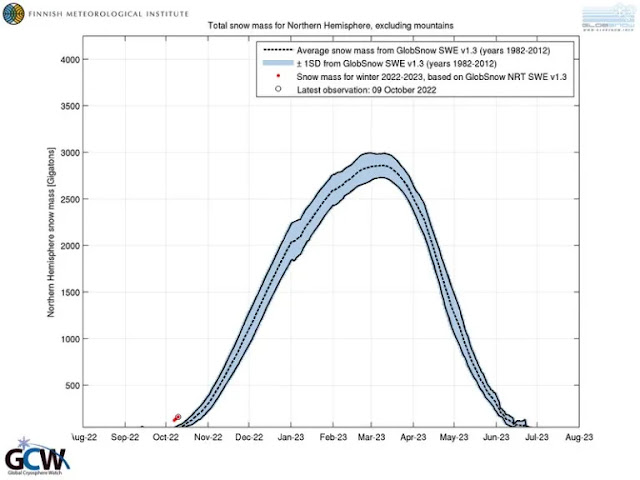LATE-SEASON POLAR COLD GRIPS SOUTH AMERICA
A spell of record-breaking, late-season cold is continuing to grip vast swathes of the South American continent.
Temperatures have plummeted in North Argentina, Uruguay, Paraguay and Southern Brazil in recent days, with rare October frosts noted at low elevations in Uruguay and Paraguay, in particular.
Paraguay’s capital Asuncion, for example, is registering daytime highs of <15C (<59F), which is around 13C below the multidecadal norm.
Looking ahead, via the latest GFS run (shown below), South America’s chill is only forecast to persist:
A spell of record-breaking, late-season cold is continuing to grip vast swathes of the South American continent.
Temperatures have plummeted in North Argentina, Uruguay, Paraguay and Southern Brazil in recent days, with rare October frosts noted at low elevations in Uruguay and Paraguay, in particular.
Paraguay’s capital Asuncion, for example, is registering daytime highs of <15C (<59F), which is around 13C below the multidecadal norm.
Looking ahead, via the latest GFS run (shown below), South America’s chill is only forecast to persist:
GFS 2m Temperature Anomalies (C) Oct 10 – Oct 15 [tropicaltidbits.com].
September 2022 in Bermuda was a cold one.
The British Island territory finished with an average temperature of 26.8C (80F), which -0.4C below the multidecadal norm.
WHEAT SPIKES
Wheat futures surged almost 8% on Monday as traders responded to Russia’s barrage of missile attacks on cities across Ukraine which further risk the UN-brokered accord between the nations on an export corridor for Black Sea grains.
Ahead of Russia’s attacks on cities including Kyiv, Dnipro and Lviv, traders had already expected the Black sea exports to come under increasing threat following critical damage to a Russian-built bridge on Saturday that connects Russia with Crimea.
“I think it goes back to the fact nearly 30% of the world’s wheat exports could be in some sort of jeopardy if the Black Sea Export Corridor agreement is not extended,” Larry Shonkwiler of Advance Trading told Agricensus.
“Corn and wheat are all related to the war’s escalation. Traders are starting to wonder if Russia will not renew the safe passage agreement,” said senior grain and oilseed commodity analyst at Futures International Terry Reilly.
The agreement is currently due to run through November 20.
CHINA, JAPAN, AND THE KOREAS SWING FROM HEAT TO RECORD-SMASHING COLD AND SNOW
Plunging Arctic cold, which has been felling low temperature and snowfall records in Eastern Russia and Mongolia for the past few months, has now descended into China, Japan and the Koreas.
This region of the world has suffered a drastic turnaround, from heat to record-smashing chills in a matter of 24-48 hours.
Hundreds of low temperature records have fallen in Central and Eastern China, with historically-early snowfall observed in many locales, including in Shenyang; while in North Korea, freezing lows have been logged across the country and even near sea level, too — a monthly record of -10C (14F) fell here, at an elevation of 1,300m (4,000ft).
The snow in Shenyang has entered the record books as the second-earliest settling snow since meteorological data began (well-over a century ago). For reference, the city’s earliest-ever snow remains Oct 8, 1969 (so only 1 day earlier).
And elsewhere, by Oct 10, snow in the province’s Zhangwu and Kangping was ankle-deep, reports news.cgtn.com.
With the higher reaches of Anhui Province also reportedly busting records:
Snow is now penetrating regions of Southwest China, too, such as Sichuan Province:
China has suffered a classic ‘swing between extremes‘ (see comparison graphic below) — a natural phenomenon foreseen to increase as historically low solar activity continues to weaken the jet streams and revert their usual straight ZONAL flow to wavy MERIDIONAL ones.
If climate alarmists are dim-witted enough to claim that China’s recent ‘red’ is evidence of catastrophic global warming, then surely they should give some balance and recognize that the now infiltrating ‘blue’ is evidence of global cooling. To their simple minds this is surely only logical; and if not, then what exactly is behind the invading early-season and record-smashing freeze? Or are we to believe that record heat is exaggerated by man’s activities and that equally record-breaking cold is entirely natural?
Rather than offering up an explanation however, most alarmists –those spoon fed their ‘apocalypse’ by a corrupted MSM– aren’t privy to worldly outbreaks of cold, only heat, and so haven’t been given a reason to stop, think and formulate an answer.
If they ever were permitted to pause and use their own minds –a process the factory schooling system has worked hard to stamp out– I’d like to think their answer would sound something like this: The planet experiences pockets of heat and pockets of cold, and these pockets can shift on a dime. It is a waning Sun that is the root cause of these increasingly-violent ‘swings between extremes’, not CO2; and, moving forward, if low solar activity continues its intensification –as forecast– then the extremes should intensify with it, as the planet –overall– cools.
Asia’s record-busting, early-season snows, particularly those depths building in Siberia and NE Russia, have already driven the 2022-23 season’s Total Snow Mass for the Northern Hemisphere to well-above average levels (shown below).
As we’ve witnessed over the past few years now, NH snow cover is clearly increasing — another inconvenience that the AGW Party is having to pull double-shifts in order to explain-away.
Finnish Met Inst.
Recommend this post and follow
The Life of Earth






No comments:
Post a Comment
Stick to the subject, NO religion, or Party politics